What David's Ankles Can Teach Us
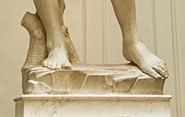
This article originally appeared in Yale Engineering magazine.
There’s no way Michelangelo could have known that David would be the most famous statue in the world 500 years after its completion. But what if he had? Would he still have chosen marble, or done anything else differently? Generally, artists want their works to last — how can they best choose the right materials for their art?
Those are the kinds of questions at the heart of The Materials Science of Art, a course that highlights the science that goes into the making of art, and how an artist’s choice of materials affects the look and life expectancy of that work.
“The conceit of the class is that when artists are making works of art, they are engineering,” said Paul Whitmore, director of the Aging Diagnostics Lab at the Institute for the Preservation of Cultural Heritage (IPCH). “They’re using the materials that they’ve learned to use or experimenting with other materials to get a certain look or a certain form, which have to last to have their message persist.”
The course was the idea of Kyle Vanderlick, former dean of the School of Engineering & Applied Science. She saw the course as an opportunity to bridge the West Campus, where the IPCH is based, with the main campus. Also, it would be a great showcase for the Greenberg Engineering Teaching Concourse — a new teaching space funded with a $10 million donation from Glenn Greenberg ’68 with six state-of-the-art labs. It was completed just a few months before the course was offered.
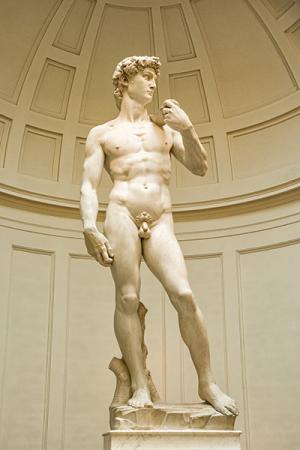
Vanderlick is well-acquainted with the IPCH, having served on its faculty advisory committee. IPCH also assisted Vanderlick on a study in her lab on a gecko-inspired technology for cleaning dust from artwork. She figured the IPCH would be the perfect partner to highlight how engineering principles can guide the choices that artists make.
“I was really glad to be the catalyst for this collaboration — it’s the perfect marriage,” said Vanderlick, the Thomas E. Golden, Jr. Professor of Chemical & Environmental Engineering. “This is the kind of thing that Yale excels at. If Yale can’t pull this off, then it’s not happening.”
Whitmore agreed that the course could be a great way to merge the two fields. They recruited Kate Schilling, a chemical engineer, to co-teach the course with Whitmore. Schilling saw the course as a way to show the many applications of engineering to students who might not otherwise get a chance to see its possibilities.
“We want to open up the world of materials science and engineering to students not typically engaged in STEM fields,” she said.
The course’s creators also relished the opportunity to take a deep dive into an aspect of the artistic process that’s often overlooked. While the purely creative side of art may be what grabs the most attention, Whitmore notes that the practical decisions are what allow art to come to fruition — and hopefully, stay with us for a while.
“The class is an exploration of the nature of the materials,” he said. “What materials and fabrication methods are artists choosing and why are they making those choices? How different would things have been if they had chosen different materials?”
For instance, Whitmore said, Michelangelo wasn’t just carving stone randomly when he made David. He was carefully designing it so that the center of gravity would be just so, and the posture would be a reasonably stable one. He compares the process of making art to how a building is made. On one side is the architect, who has a specific vision for the building he’s designing. Then there are the engineers and construction people who look at the designs and decide whether they’re practical. The artist takes on both of these roles — “they have to be the thinkers and the doers.”
Whitmore stresses that the course is not a research project to help future artists. Rather, he said, it’s meant to pull back the curtain on what artists have already done and how they typically work. He wants the course to show the thinking and choices that were made that led to the creation of something that lasted 500 years and, hopefully, another 500.
“I’m not trying to advise artists on how to make art,” he said. “If they want to make ice sculptures that last a day, that’s perfectly fine. But it should be a conscious choice — it shouldn’t be a surprise when the ice sculpture is gone the next day.”
The Materials Science of Art course was broken into three sections: sculpture, photography, and paint. For the sculpture portion, Whitmore and Schilling wanted to focus on Michelangelo’s David — specifically, its ankles. Completed in 1504, the statue was remarkably well-constructed, but it’s been more than 500 years, and time takes a toll on everything. Hairline cracks have been showing up in David’s ankles. It’s a problem that had been known to some degree for many years, but only in 2014 did researchers pinpoint the problem: An imbalance of the statue’s load when its pedestal shifted, applying new forces on the ankles — the weakest part of the statue.
Whitmore and Schilling figured these tiny cracks could serve as a window to the artistic process and how a work changes over time. One semester before the class was offered, Whitmore and Schilling sought help from Introduction to Engineering Innovation & Design (ENAS 118), a course that matches student teams with “clients” from across campus. Together, they identify specific problems and devise solutions. The IPCH-ENAS 118 collaboration focused on developing a lesson plan to explore the nature of materials in sculpture, keeping David’s aging ankles in mind. The task fell to the student team of Ting Gao, Michelle Tong, Sinem Sinmaz, Julien Fernandez, and Zach Metcalf.
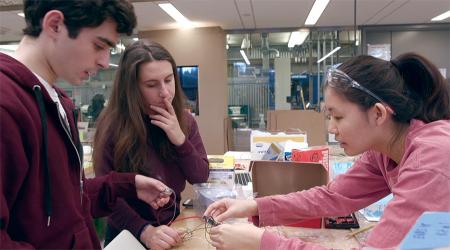 Working in the John Klingenstein ’50 Design Lab at the Center for Engineering Innovation & Design (CEID), the five students brainstormed and came up with “a lot of crazy ideas.” Among the candidates were a mini-hydraulic press, a plate that could move on all four corners, a replica of David sliced up with different amounts of pressure applied at different points.
Working in the John Klingenstein ’50 Design Lab at the Center for Engineering Innovation & Design (CEID), the five students brainstormed and came up with “a lot of crazy ideas.” Among the candidates were a mini-hydraulic press, a plate that could move on all four corners, a replica of David sliced up with different amounts of pressure applied at different points.
“We talked to our mentors [Larry Wilen and Vince Wilczynski] and they said “Maybe take a few steps back,’” Sinem Sinmaz ’21 said. “By ‘a few’ I think they meant ‘a lot.’”
After consulting with Wilen and Wilczynski, they realized that the crux of the issue was neither the weight nor the posture of the statue by themselves, but how the two together created torque.
“Then we realized that recreating torque can most easily be done by having a lever arm and a weight without actually angling anything,” said Ting Gao ’21. “We basically looked at what David was actually experiencing and what are the physical problems and then broke that down to pure physics.”
That came down to making numerous “Tetris blocks” — small s-shaped objects that could simulate the physics of the ankles on Michelangelo’s masterpiece. They 3D-printed the molds and made the blocks from different materials.
To test the strengths of the blocks, they designed and built FRED (Force Relay Exertion Device). The device can hold the test block in place and has a mechanism that allows the user to apply pressure to the block by a hand crank. With this, they could see how much force and at what angles each model could withstand before breaking.
Wilczynski and Wilen were impressed with the student team’s efforts. Wilczynski noted that they try to assign projects that can succeed based on the principles taught in the course’s six labs. So it was gratifying when the students working on David’s ankles developed FRED based on one of their labs.
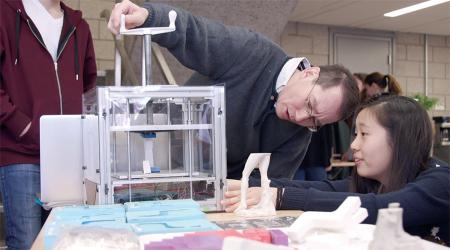 “We have a lab in which we do dissection of a biomedical device,” he said. “There are various medical tools, and they take them apart — and one is a digital scale with four sensors in it. The students working on the David challenge recognized that they could use that, and said ‘Oh, four-sensor load cells, let’s use that on David’s ankles.’”
“We have a lab in which we do dissection of a biomedical device,” he said. “There are various medical tools, and they take them apart — and one is a digital scale with four sensors in it. The students working on the David challenge recognized that they could use that, and said ‘Oh, four-sensor load cells, let’s use that on David’s ankles.’”
As if figuring out the physics of David’s ankles wasn’t tricky enough, the team also had to come up with a way to teach it to students who may not have the same science background.
“We had to create activities for people with very little physics experience to allow them to work with it and really understand it on a fundamental level,” Michelle Tong ’21 said.
Schilling said the student team’s solution helped her students understand the science behind David’s failing ankles.
“It’s a conceptually accessible device, but also telling the engineering story of Michelangelo’s David in a way their peers could connect to was an incredible help to us and our students,” she said. “Peer-to-peer instruction is often crucial for helping students learn new and difficult concepts. Not only do the students see that it is possible for them to succeed, but they also benefit from having common perspectives and communication styles.”
Wilen said the challenge was fairly open-ended, so the students could have gone in several different directions. Regardless of the outcome, he said, the main thing is what the students gain from the experience.
“We love to see successful projects, but if this hadn’t been successful but they learned a ton and worked really hard, that would be great also,” he said.
As it happened, though, the project succeeded on all levels. Whitmore and Schilling used FRED and the simplified ankle models in their course, allowing their students to explore for themselves the physics of an aging masterpiece.
“We can’t destroy David, so we make crash test dummies that we can destroy and be able to explore something about that particular work of art,” Whitmore said. “These help us look at such things as whether Michelangelo had made David out of rubber-reinforced plaster and how would that behave. Would it be vulnerable in the same way?”
So if they could go back to 16th century, what would the student team tell Michelangelo?
“Why don’t you just 3D print it — and use polylactic acid?” Gao said, laughing.
In reality, the students said, it’s not a matter of what Michelangelo could have done differently but understanding the choices that he made. Over five centuries, just about any material is going to show its age — it’s just a matter of how.
“If Michelangelo used this other material there would have been other consequences,” Sinmaz said. “Instead of cracking in this place, for instance, it might have crumbled.”
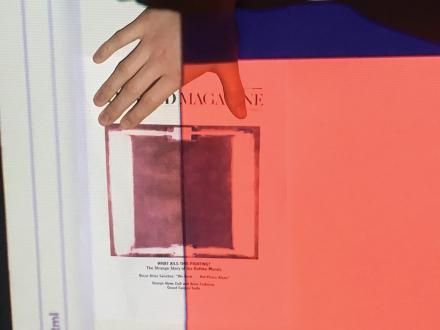 The paint section of the course was inspired by the work of Mark Rothko — specifically, a series of mid-century paintings commissioned by Harvard University that eventually suffered from faded colors. Using a kind of paint with a chemical makeup similar to the ink used in Sunday newspaper comics, the artwork originally boasted vivid hues. The paintings, however, were intended to be displayed in a room filled with sunlight, and those eye-popping reds quickly aged to a dull blue. At a 2014 exhibit at Harvard, the paintings were returned to their former glory, thanks to exhibition lighting designed to project particular colors onto the canvases, transforming the colors to closely match their original appearance.
The paint section of the course was inspired by the work of Mark Rothko — specifically, a series of mid-century paintings commissioned by Harvard University that eventually suffered from faded colors. Using a kind of paint with a chemical makeup similar to the ink used in Sunday newspaper comics, the artwork originally boasted vivid hues. The paintings, however, were intended to be displayed in a room filled with sunlight, and those eye-popping reds quickly aged to a dull blue. At a 2014 exhibit at Harvard, the paintings were returned to their former glory, thanks to exhibition lighting designed to project particular colors onto the canvases, transforming the colors to closely match their original appearance.
The exhibit, Whitmore said, prompted numerous philosophical questions: Were viewers really seeing the work as Rothko’s had intended it to look, or an illusion of it? Why do we generally accept the wear and tear of artwork created centuries ago, but are disturbed when that aging happens within our lifetime?
From a pure science standpoint, though, Whitmore called the paintings’ transformation “a completely jaw dropping experience.”
“It was so amazing and wonderful that you could do such a thing,” he said. “When I did that, I said ‘I want my students in my class to feel it like I feel now — because they will get hooked.’”
When preparing a lesson based on the exhibit in his lab, he replicated the recovery of faded paint color with tailored colored light projections. Working with the same fundamental science, the students experienced the same breath-taking success.
Another section was also inspired by fading colors, this time in photography. The students looked at why photos in “The Pencil of Nature,” a series of booklets of photographs by 19th-century photographic pioneer William Henry Fox Talbot, had faded to ghostly remnants of the original images. Essentially, the work was designed as a promotion for the potential of photography — then, in its very early stages. Over a very short time, though, the images had faded significantly. Whitmore’s previous experiments showed that light exposure wasn’t the culprit, and that certain chemical processes were more likely to blame.
“For the lab in this class, we made some salt prints just like the ones that Talbot had made and exposed them to peroxide to see if that could have been what happened to those images in ‘The Pencil of Nature,’” he said.
Ultimately, he said, these three labs are the kinds of explorations that conservators and scientists engage in to learn how to best preserve art without fundamentally changing it. For instance, conservators might try to use titanium pins to repair a broken sculpture, but those pins may end up causing their own problems down the line. With more options available to them, they can avoid those issues. Those additional options will be invented more and more as the art world collaborates with engineering.
“Art preservation has become more sophisticated as more conservators become engaged with the technical expertise they need,” Whitmore said. “The conservator can’t become an engineer easily, but they’re no longer bench practitioners in isolation at the museum either. They are connected with the academics and the industrial experts they need to answer some of these questions and add to the toolkit that they use for their work.”

